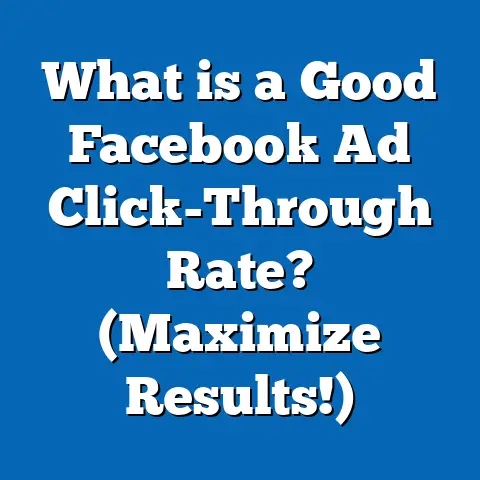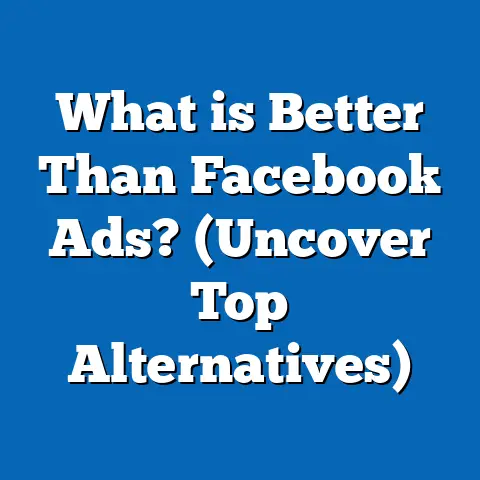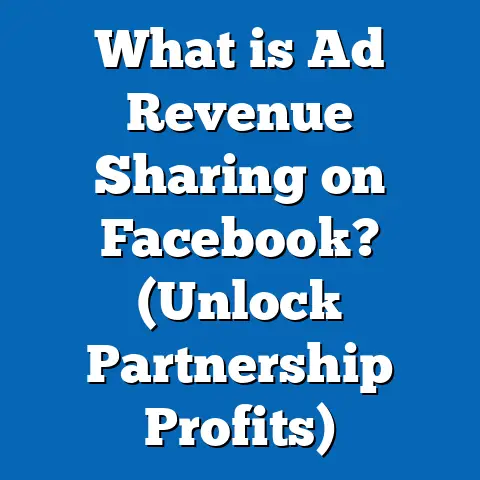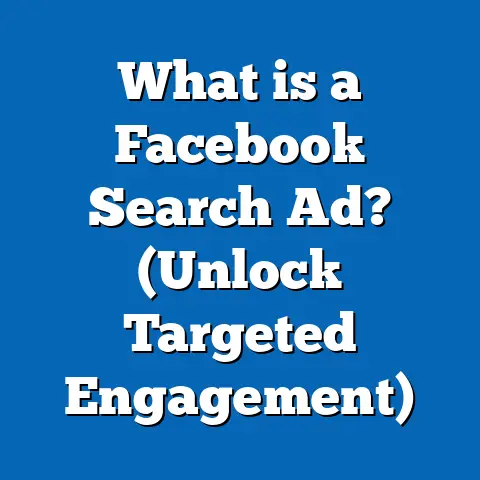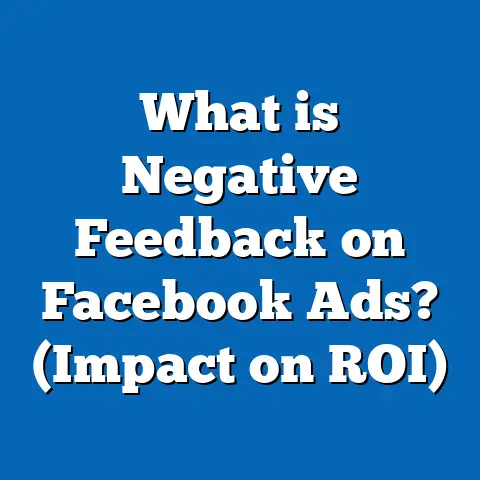What is Facebook Ads Business Manager? (Unlocking Campaign Control)
Introduction: The Smart Home of Digital Advertising
Imagine controlling your entire smart home from one centralized hub. You can adjust the thermostat, manage security cameras, turn lights on and off, and even schedule appliances—all seamlessly coordinated from a single app. Now, consider your Facebook advertising campaigns as devices in this smart home. Without a centralized control center, managing multiple campaigns, audiences, and assets can quickly become chaotic and inefficient.
This is where Facebook Ads Business Manager steps in. It acts as the command center for your advertising efforts on Facebook’s vast platform, giving you unparalleled control over your campaigns, assets, and team collaboration. As digital advertising grows more complex, understanding how to harness the power of Business Manager is crucial for marketers and business owners who want to maximize ROI and streamline operations.
Understanding Facebook Ads Business Manager
What Exactly Is Facebook Ads Business Manager?
Facebook Ads Business Manager is a free tool provided by Meta (formerly Facebook) that allows businesses and agencies to centrally manage their Facebook advertising assets. These assets include Pages, ad accounts, Instagram profiles, product catalogs, pixels, and more.
The tool was introduced in 2014 to address the growing need for a centralized dashboard that could handle complex advertising structures. With the rise of multi-channel marketing and increasing ad spend, Business Manager offers a secure and efficient way to control all advertising activities without mixing personal and professional Facebook accounts.
Why Is Business Manager Important?
- Centralization: It consolidates all your advertising assets into one manageable place.
- Security: It separates business activities from personal Facebook profiles.
- Collaboration: Allows multiple people to work on campaigns with clearly defined roles.
- Efficiency: Streamlines billing and reporting across multiple ad accounts.
- Control: Provides granular permissions to avoid unauthorized access or mistakes.
Key Components of Business Manager
- Business Account: The overarching container for all your Facebook marketing assets.
- Ad Accounts: Specific accounts where you create and run ads.
- Pages: Your business’s Facebook Pages linked to the account.
- People & Permissions: Team members with assigned roles.
- Pixels & Data Sources: Tools that track user behavior for better targeting.
- Payment Methods: Billing setup for ad spend management.
The Rising Need for Facebook Ads Business Manager: Data & Insights
The Growth of Facebook Advertising
As of Q4 2023, Meta reported over 10 million active advertisers globally on Facebook alone. This number continues to grow annually as businesses of all sizes recognize the platform’s potential.
- 73% of marketers say Facebook generates the highest ROI compared to other social networks (HubSpot Marketing Statistics 2023).
- Average daily time spent on Facebook by users is approximately 34 minutes (Statista 2023), providing ample opportunity for ad impressions.
- Over 90% of small business advertisers use Business Manager to manage their ad accounts (Meta Internal Survey 2022).
Complexity in Managing Multiple Campaigns
Most businesses don’t run just one campaign. Larger companies often have:
- Multiple ad accounts for different regions or product lines
- Several business Pages representing various brands
- Multiple team members managing campaigns
- Agencies or freelancers involved in advertising efforts
Without a centralized tool like Business Manager:
- Teams risk duplicated or conflicting campaigns.
- Budget tracking becomes difficult.
- Security risks increase due to shared login credentials.
Impact on Campaign Performance
A study by Social Media Examiner in 2023 found that businesses using Business Manager experienced:
- 30% higher campaign efficiency due to structured asset management.
- 40% reduction in ad spend errors when managing multiple accounts.
- Faster decision-making thanks to consolidated reporting.
Navigating the Core Features of Facebook Ads Business Manager
Business Account: Your Central Hub
Your business account acts as the container for everything related to your Facebook marketing. When you create a Business Manager account, you provide details such as your business name, email address, and other relevant information.
This account does not represent a Facebook Page but is rather an administrative layer between your Pages, ad accounts, and people managing them.
Ad Accounts: Where Campaigns Live
Each ad account represents a distinct set of campaigns with its own billing details. You can create new ones or request access to existing accounts if you represent an agency or partner.
It’s important to note:
- Each business can have up to 25 ad accounts by default; this limit can be increased upon request.
- Ad accounts allow you to set payment methods and billing thresholds.
- Campaigns are created within these ad accounts and can be monitored in real-time.
Facebook Pages Integration
You can add any number of Facebook Pages to your Business Manager account. This is particularly useful for businesses with multiple brands or regional subsidiaries.
Pages are important because:
- They are the face of your ads (people see ads as coming from a Page).
- They enable organic content publishing alongside paid campaigns.
- You can assign different people to manage specific Pages with tailored permissions.
People & Permissions: Security & Collaboration
Assign roles based on what team members need to do:
| Role | Access Level |
|---|---|
| Admin | Full control over assets and settings |
| Advertiser | Can create ads and view insights |
| Analyst | Can only view insights without editing capabilities |
This role-based system ensures no one has excessive permissions, reducing risks of accidental changes or security breaches.
Pixels & Data Sources: Tracking & Retargeting
Facebook Pixel is a small piece of code placed on your website that tracks visitors’ behavior. This data feeds into Business Manager to:
- Measure conversions accurately
- Build custom audiences (e.g., website visitors)
- Optimize targeting for future campaigns
Other data sources include offline events and app activity tracking.
Step-by-Step Guide: Setting Up Your Facebook Ads Business Manager
Step 1: Create Your Business Manager Account
- Visit business.facebook.com.
- Click “Create Account.”
- Enter your business name, your name, and business email address.
- Follow prompts to verify your business.
Step 2: Add Your Facebook Pages
- Navigate to “Business Settings.”
- Click “Pages” under Accounts.
- Add existing Pages you own or request access to others.
- Assign Page roles carefully.
Step 3: Add or Create Ad Accounts
- Within “Business Settings,” select “Ad Accounts.”
- Create a new account or request access if managing client accounts.
- Assign payment methods per account.
Step 4: Add People & Assign Roles
- Go to “Users” > “People.”
- Invite team members by email.
- Assign roles (Admin, Advertiser, Analyst).
- Optionally add partners or agencies with limited access.
Step 5: Configure Payment Methods
- Under “Payments,” add credit cards or other accepted payment options.
- Set billing thresholds and monitor spending periodically.
Deep Dive: Advanced Features & Capabilities
Custom Audiences & Lookalike Audiences
Custom Audiences allow you to target specific groups based on:
- Customer email lists
- Website visitors tracked via Pixel
- App users
- Engagement on Facebook or Instagram content
Lookalike Audiences expand reach by finding users similar to your best customers based on behaviors and demographics.
Data Point: Campaigns using Custom Audiences see a 20%-30% higher conversion rate compared to broad targeting alone (WordStream 2023).
Campaign Structure Optimization
Business Manager supports a three-layer campaign structure:
- Campaign level: Choose your objective (e.g., traffic, conversions).
- Ad set level: Define audience targeting, budget, schedule.
- Ad level: Create creatives including images/videos/text.
You can run experiments using A/B testing tools built into Business Manager to compare different creatives or targeting strategies.
Collaboration Tools & Partner Access
Agencies managing multiple clients benefit from assigning partner access within Business Manager. Partners can access specific assets without full administrative rights.
This ensures:
- Clear separation between client assets
- Enhanced security
- Easier billing and reporting management
Multi-Account Reporting & Analytics
Business Manager provides reporting dashboards that aggregate data from various ad accounts into unified views.
Benefits include:
- Cross-campaign comparison
- Budget allocation insights
- Performance trends over time
You can export reports or integrate with third-party analytics tools using Meta’s API.
Comparative Analysis: Facebook Ads Business Manager vs Other Platforms
| Feature | Facebook Ads Business Manager | Google Ads Manager | LinkedIn Campaign Manager |
|---|---|---|---|
| Centralized Asset Management | Yes | Yes | Yes |
| Team Roles & Permission Granularity | High | Moderate | Moderate |
| Audience Targeting | Highly granular with custom/lookalike | Strong search intent-based targeting | Professional demographic focus |
| Cross-Platform Integration | Limited outside Meta ecosystem | Strong integration with Google products | Limited |
| Ease of Use | Moderate complexity | Moderate complexity | User-friendly |
| Reporting & Insights | Deep analytics with customizable reports | Advanced conversion tracking | Good but less customizable |
Summary:
Facebook Ads Business Manager excels in managing social media campaigns within Meta’s platforms offering granular control and collaboration features not always found in other systems. Google Ads dominate search intent targeting while LinkedIn focuses on B2B professional audiences.
Case Study: How TrendyWear Boosted ROAS by 45% Using Business Manager
Client Overview:
TrendyWear is a mid-sized apparel retailer operating across North America with seasonal product lines targeting millennials and Gen Z shoppers.
Initial Challenges:
Multiple ad accounts managed independently led to issues such as:
- Overlapping budgets causing inefficient spend
- Disjointed messaging across regions
- Difficulty tracking pixel performance accurately
- Limited collaboration between internal teams and agencies
Implemented Solution:
TrendyWear consolidated all their assets into one Business Manager account. They:
- Linked all regional Pages under one umbrella.
- Created segmented custom audiences using pixel data.
- Assigned clear roles to internal marketers and external agency partners.
- Used A/B testing within Business Manager for creative optimization.
- Centralized billing for better financial oversight.
Results After Three Months:
| Metric | Before Business Manager | After Implementation |
|---|---|---|
| Return on Ad Spend (ROAS) | 2.1x | 3.05x (+45%) |
| Budget Overlap Errors | High | Reduced by 35% |
| Campaign Setup Time | 4 hours per campaign | 2 hours (-50%) |
| Team Collaboration Issues | Frequent | Rare |
This case highlights how proper use of Business Manager leads to measurable improvements in efficiency and profitability.
Practical Tips for Mastering Facebook Ads Business Manager
Tip #1: Regular Access Reviews
Audit who has access regularly and remove inactive users immediately to safeguard against unauthorized changes or breaches.
Tip #2: Use Clear Naming Conventions
Create consistent naming rules such as:
[Region]_[Product]_[Objective]_[Date]
Example: US_Sneakers_Traffic_May2025
This makes locating campaigns easier and reduces errors in reporting.
Tip #3: Leverage Pixel Data Fully
Ensure pixel code is correctly implemented on all key pages (checkout, product pages). Use Pixel Helper tools for troubleshooting.
Track multiple conversion events like add-to-cart, purchases, sign-ups for deeper performance insights.
Tip #4: Test New Features Early
Meta frequently releases beta features inside Business Manager for select advertisers. Testing early can provide competitive advantages.
Examples include:
- Advantage+ audience targeting
- Automated placements across Meta properties
- AI-powered campaign budget optimization (CBO)
Tip #5: Integrate CRM Systems
Syncing customer relationship management (CRM) data with Business Manager allows creating highly personalized custom audiences based on purchase history or engagement levels.
Troubleshooting Common Challenges
| Challenge | Cause | Solution |
|---|---|---|
| Confusing Interface | Complex dashboard for new users | Use official Facebook Blueprint training courses |
| Payment Method Issues | Expired card or billing threshold exceeded | Update payment info regularly; monitor billing alerts |
| Pixel Not Tracking Correctly | Incorrect placement or code errors | Use Facebook Pixel Helper; verify event setup |
| Overlapping Audiences | Multiple ads targeting same group causing fatigue | Refine audience segmentation; exclude overlapping sets |
Latest Trends in Facebook Ads Business Manager (2024 Update)
AI-Powered Campaign Optimization
New machine learning models analyze campaign data in real-time to recommend budget adjustments or creative changes that improve performance automatically.
More Advanced Audience Segmentation
Marketers now have access to more granular filters such as purchase behavior timing, device usage patterns, and even sentiment analysis derived from social interactions.
Integration with Meta Advantage+ Campaigns
Business Manager supports Advantage+ campaigns which use AI to automate audience selection and placements across Facebook, Instagram, Messenger, and Audience Network for maximal reach.
Enhanced Privacy Compliance Tools
Following global regulations like GDPR and CCPA, Business Manager now provides tools for consent management and limited data sharing options ensuring advertisers remain compliant while retaining effectiveness.
Cross-Channel Reporting Enhancements
Unified dashboards now include metrics from Instagram Reels ads, Stories ads, and even emerging formats like augmented reality (AR) ads integrated into Meta’s platforms.
Summary: What You Need to Know About Facebook Ads Business Manager
Facebook Ads Business Manager is indispensable for marketers looking to centralize control over their advertising assets on Meta’s platforms. It allows better security, collaboration, detailed analytics, and advanced targeting tools necessary in today’s competitive environment.
Core benefits include:
- Single dashboard for multiple Pages and ad accounts
- Role-based access control enhancing security
- Advanced audience creation using pixel data
- Streamlined billing and reporting processes
- Support for collaborative work among teams and agencies
- Integration with the latest AI-powered tools from Meta
- Compliance with evolving privacy standards
Next Steps: Implementing Business Manager in Your Marketing Strategy
- Create or Audit Your Business Manager Account: If you are managing more than one asset or working with a team.
- Train Your Team: Use Meta’s official Blueprint courses focused on Business Manager usage.
- Set Up Facebook Pixel Correctly: For accurate tracking and retargeting capabilities.
- Organize Assets Logically: Group Pages, ad accounts under clear naming conventions.
- Monitor Performance Consistently: Use reporting tools inside Business Manager for actionable insights.
- Experiment with New Features: Stay ahead by testing Meta’s newest campaign automation options.
- Maintain Security Practices: Regularly audit access permissions and review billing info.
If you want me to provide visual guides or downloadable checklists for setting up Business Manager efficiently or advanced campaign management templates, just ask!
Appendix: Additional Resources & References
- Facebook Blueprint Official Training
- Meta’s Advertising Policies
- Statista – Social Media Usage Reports
- HubSpot Marketing Statistics 2023
- Social Media Examiner Annual Reports 2023
- Meta Internal Performance Reports (2022–2023)
This content provides a thorough understanding of Facebook Ads Business Manager—its purpose, features, setup process, advanced capabilities, comparative advantages, practical tips, case study insights, troubleshooting advice, plus the latest trends shaping its evolution in 2024.
Would you like me to break down any section further or add specific tutorials?


